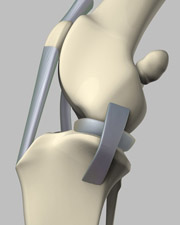MU Researchers Work to Create More Permanent Joint Replacements
NIH grant funds research that will develop biological joints for human and dog knees and hips
June 23, 2009
Story Contact: Kelsey Jackson, (573) 882-8353, JacksonKN@missouri.edu
COLUMBIA, Mo. - Instead of using plastic and metal in joint-replacement surgery, surgeons may soon be able to use living tissue grown in a specialized petri dish. With the help of a $3.1 million grant from the National Institutes of Health, University of Missouri researchers, in collaboration with colleagues at Columbia University in New York City, will expand their biological joint technology that uses living tissue instead of plastic and metal to replace damaged joints. This new technology, which responds in ways similar to normal cartilage in a healthy joint, could prevent patients from having complications that result in repeat joint-replacement surgeries.
"A living biological implant may serve as a more permanent clinical option for joint replacement than existing commercial implants of metal and plastic, thereby revolutionizing the field of joint arthroplasty," said James Cook, professor of veterinary medicine and surgery and the William C. and Kathryn E. Allen Distinguished Professor in Orthopaedic Surgery. "Each joint has a different architecture and different properties. We can take the basic concept that we developed for the knee and tailor it to help other joints, such as the hip, elbow and shoulder."
In recent studies, the researchers have taken the lab-grown cartilage and molded it into new knees and hips for dogs. The biological joints allow for all of the tissue in a normal joint to be "grown" together such that the different types of tissues can "communicate" as they do in the actual joint. Researchers at MU's Comparative Orthopaedic Laboratory (COL) and Columbia University's Cellular Engineering Laboratory (CEL) have shown that this system maintains the appearance, composition and function of all types of tissues.
With the new grant, COL and MU School of Medicine Department of Orthopaedic Surgery researchers will continue their work with Clark Hung, associate professor of biomedical engineering at Columbia University, and his CEL group to expand biological joint technology to human patients. Dogs have similar physical characteristics and serve as the best model for human knee and hip problems, Cook said.
"Now, the goal is to develop replacement parts that will work with humans as well as dogs," said Sonny Bal, associate professor of orthopaedic surgery in the MU School of Medicine who is working with Cook for the human application of the technology. "Future replacement parts will require the use of composite structures that can mimic the anatomic properties of bone and cartilage. We are collaborating with material scientists at Missouri University of Science and Technology to come up with suitable bone substitute materials for tissue-engineering applications."
Cook and Hung's previous research on development and testing of biological joints has been published in several journals including Current Rheumatology Reviews, Tissue Engineering and Journal of Biomechanics.
-30-





 Photos (2):
Photos (2):